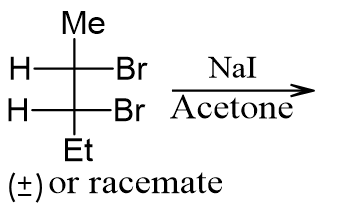Maths-
General
Easy
Question
Number of solutions of the equation Sin x + sin2x + sin3 x + sin4x + ……. Π= 2 where x Π[0,4Π], is
- 2
- 4
- 5
- 6
The correct answer is: 4
Sin x (1 + sin x + sin2 + ….. ) = 2


 only in
only in
there are 2 solution in [ 0, ]
]
And again we set 2 solution for same intervel in 
Total solutions are 4
Related Questions to study
Maths-
The number of real solutions of the equation  is
is
The number of real solutions of the equation  is
is
Maths-General
Maths-
For which of the following values of m is the area of the region bounded by the curve y =x - and the line y = mx equal to 9/2…
and the line y = mx equal to 9/2…
For which of the following values of m is the area of the region bounded by the curve y =x - and the line y = mx equal to 9/2…
and the line y = mx equal to 9/2…
Maths-General
Maths-
The area of the region bounded by y = and y =-
and y =- +1 is…
+1 is…
The area of the region bounded by y = and y =-
and y =- +1 is…
+1 is…
Maths-General
Chemistry-
Which of the following is the correct order of stability of the following compound?
I) 
II) 
III) 
Which of the following is the correct order of stability of the following compound?
I) 
II) 
III) 
Chemistry-General
Chemistry-
Which of the following reactions would give  -alkene?
-alkene?
I) 
II) 
III) 
IV) 
Which of the following reactions would give  -alkene?
-alkene?
I) 
II) 
III) 
IV) 
Chemistry-General
Chemistry-
 (A) (B)& (C) are:
(A) (B)& (C) are:
 (A) (B)& (C) are:
(A) (B)& (C) are:
Chemistry-General
Maths-
If the sides of a triangle ABC are a, b and c such that 2b = a + c, then exhaustive range of
then exhaustive range of  is
is
If the sides of a triangle ABC are a, b and c such that 2b = a + c, then exhaustive range of
then exhaustive range of  is
is
Maths-General
Chemistry-
 A, B, and C are:
A, B, and C are:
I) 
II) 
III) 
 A, B, and C are:
A, B, and C are:
I) 
II) 
III) 
Chemistry-General
Chemistry-
The decreasing order of nucleophilicities in  (dimethylsulphoxide) is:
(dimethylsulphoxide) is:
The decreasing order of nucleophilicities in  (dimethylsulphoxide) is:
(dimethylsulphoxide) is:
Chemistry-General
Chemistry-
In which of the following reactions,  rate increases on changing the solvent from (95% acetone
rate increases on changing the solvent from (95% acetone  ) to (80% acetone + 20%
) to (80% acetone + 20%  )?
)?
In which of the following reactions,  rate increases on changing the solvent from (95% acetone
rate increases on changing the solvent from (95% acetone  ) to (80% acetone + 20%
) to (80% acetone + 20%  )?
)?
Chemistry-General
Chemistry-
Consider the following reaction:

Find out which of the following statements is wrong?
Consider the following reaction:

Find out which of the following statements is wrong?
Chemistry-General
Chemistry-
Which of the following compounds would undergo Diels-Alder reaction?
I) 
II) 
III) 
IV) 
Which of the following compounds would undergo Diels-Alder reaction?
I) 
II) 
III) 
IV) 
Chemistry-General
Chemistry-
Arrange the following in the decreasing order of nucleophilic acyl substitution reaction?
I) 
II) 
III) 
IV) 
Arrange the following in the decreasing order of nucleophilic acyl substitution reaction?
I) 
II) 
III) 
IV) 
Chemistry-General
Chemistry-
Consider the following reaction:

The product is:
Consider the following reaction:

The product is:
Chemistry-General
Chemistry-
 Which statement is correct about the above reaction?
Which statement is correct about the above reaction?
 Which statement is correct about the above reaction?
Which statement is correct about the above reaction?
Chemistry-General





